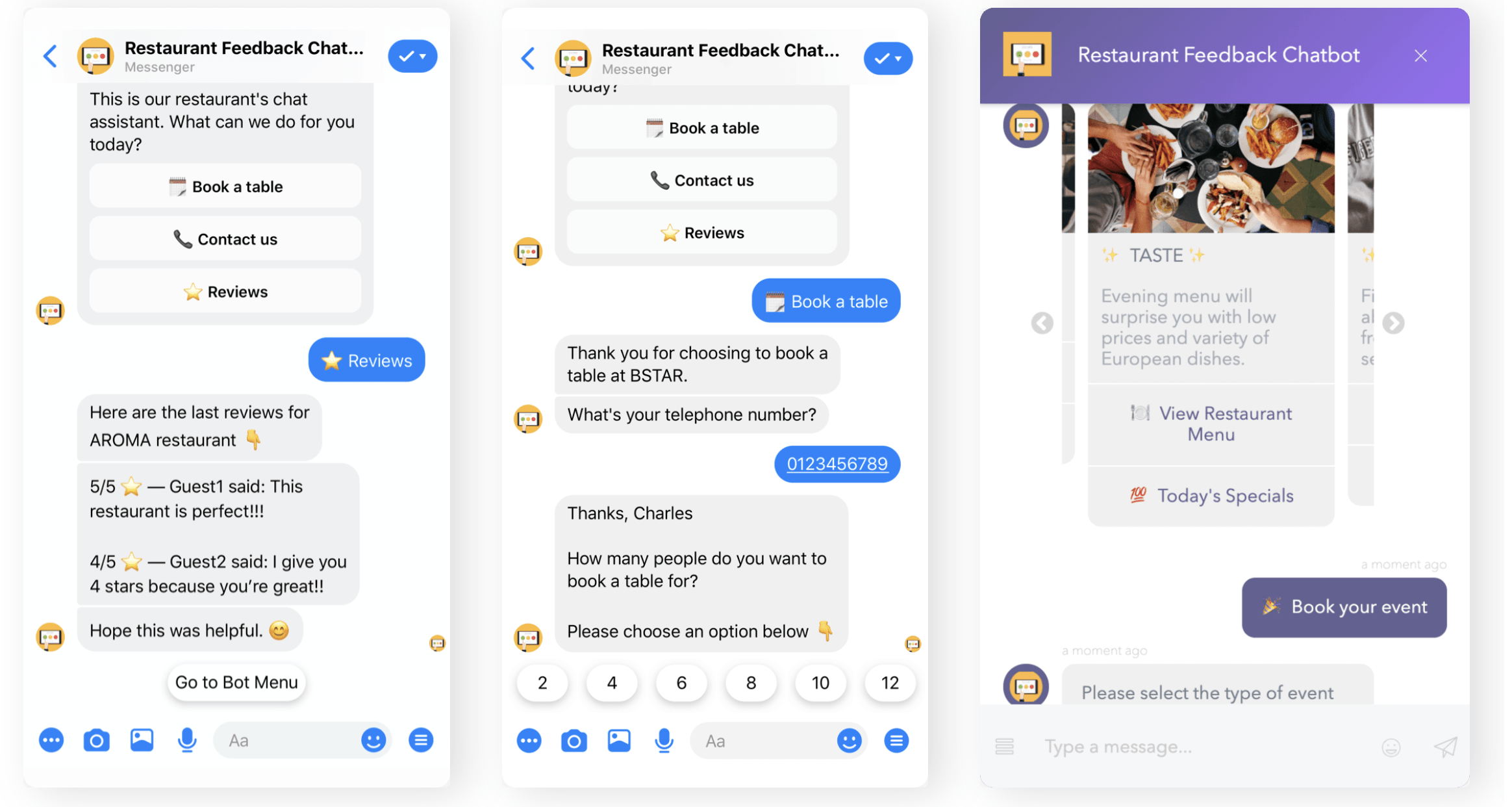Chatbots for Business: Tips on How They Can Amplify Yours [+ Real Cases]
Getting a chatbot for a business seems small. Is it really? Connecting the dots here.
Written by Olesia Melnichenko
![Chatbots for Business: Tips on How They Can Amplify Yours [+ Real Cases]](https://helpcrunch.com/blog/wp-content/uploads/2023/06/chatbots-for-business-header.png)
Would you be caught off guard if you land on an online DIY store, and a chatbot helps you, say, choose a roll of wallpaper? I beg to differ. Or suppose you decide to change your passport and need to contact local authorities to clarify the details. You reach out to a corresponding company and, what a surprise, got assisted by a chatbot. The bottom line is that bots aren’t a trend anymore – they’re a must-have.
You might agree with me on this one (no pressure, though) – these cases aren’t so hard to find now that we are in the era of robots. Businesses all across the globe and all over industries have already used smart chatbots as their professional allies.
How do they do that? Are there any pitfalls? What secrets are there?
I won’t leave you out in the cold! In this article, we will get down to the rock bottom of chatbots for business as well as some real-life examples from different companies. Strap yourself in and enjoy! 🤖
A quick side note about chatbots…
I am sure you know what a chatbot is (I mean, you were searching for it already and ended up here). Snatching at a chance, it is a specially made program that simulates a human conversation. Only a bot is faster, sometimes smarter, and everlast.
In the business dimension, bots are indispensable as they provide numerous gains. Thus, Business Insider says that consumer retail spending via these machines will reach $142 billion by 2024.
If you are standing at the parting not having the slightest of what chatbot to go for, I’ll give you a little nudge on their types:
- Choose a button-based bot if you don’t need anything extra and will do with pre-defined options;
- Grab a keyword-based chatbot for catching what users say and crafting the whole dialogue based on this info;
- Go for a ruled-based one if you’re ready to set up specific rules and tweak the conversations accordingly;
- Pick an AI-powered chatbot for business if your company is an enterprise with a lot of customer data behind the scenes;
- Play around with a hybrid model for a sophisticated harmony between a simple rule-based bot, an AI technology, and a human touch.
So, how do chatbots help businesses, and what is the driving force for them? We are about to find that out 🙌
What makes chatbots effective team players in business?
As the chatbots have already made it to the top (and do not seem to ever stop), they clearly have proved their power. Except for being at the right place at the right moment, they’re fast and furious. However, this is only part of the story. Let’s plunge deeper into the awesome business benefits of chatbots that make them effective and enduring:
- Information gathered from multiple sources: so that you don’t have to collect every bit of customer data and info about their orders, and subscription statuses, to name a few, a chatbot does it and puts everything into one place.
- Timely human handoff: sometimes, an issue needs more in-depth troubleshooting and a creative approach. If your chatbot for business knows exactly when to hand the conversation over to a human rep, you’re in luck.
- Personalized customer experience: thanks to the abundance of the chatbot’s functionalities, you can teach them customized greetings, customers’ names (or nicknames), and how to talk to returning visitors. Plus, these machines can become perfect lifesavers regarding cart abandonment and holiday-specific deals.
- Contextual self-service: gone are the days when customers made shifts with just a knowledge base on a company’s website. A modern chatbot for business use is able to suggest customers additional resources and relative content for handling their questions. If it’s AI we are talking about, it also provides product suggestions based on the user’s unique preferences.
- Automated lead generation activities: your world will get topsy-turvy with a spot-on business chatbot that can catch your website visitors and nurture them at every stage of the funnel.
Chatbots for business: 7 ways to utilize them in your working ecosystem
1. Combine forces in three directions
Support, marketing, and sales are the Holy Trinity for business. We will scrutinize each of them down the road, but I would like to make a short opening line for them: why are these three called this way, and why should you mix them up?
1) Support: if a website visitor shows up at your door asking for help, you’d better be as quick as a fox and give them answers. Chatbot is your ally in this endeavor.
2) Marketing: lead generation, customer engagement & retention, content distribution – nothing can miss from the list. Using a chatbot for business, you can collect users’ data, provide clients with relevant promo or blog materials (such as active discounts, offers, or articles that will help them untangle issues, etc.), and offer community news and updates.
3) Sales: not only can a chatbot speed up the sales process, but it also can contribute to conversion rates. Plus, you can jazz up your chatbot sales approach with canned responses so that customers receive all the necessary info without typos and in a timely manner.
I do not mean to brag, but the chatbot designed with HelpCrunch holds these three directions in balance. You can set up auto messages to flash promos, conduct surveys, and stay calm when it comes to transferring a chat to a human customer rep – the chatbot will do everything with flying colors.
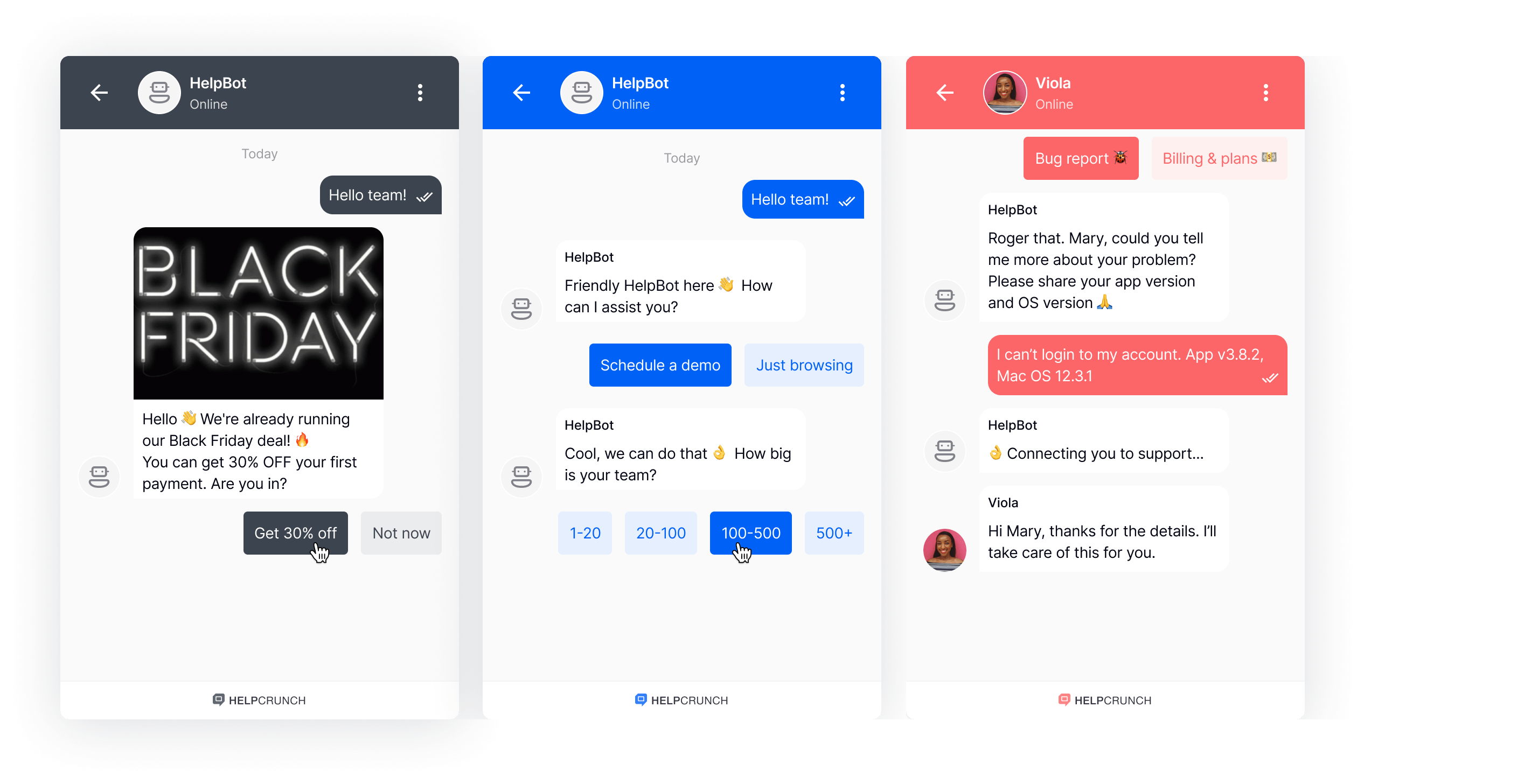
Has our HelpBot piqued your interest? 🤖 I gathered as much! I suggest you register for our free 14-day trial — this is as much time as it takes to fall in love with the HelpBot, its functionalities for support, marketing, and sales. Plus, there is a codeless builder for your flows from scratch. Or you can leverage our pre-made templates, the call is yours!
2. Equip a chatbot with an integrated knowledge base
Have you ever faced an issue while choosing clothes, tiles for your kitchen, or installing a piece of software? No one has come for help? This is why every self-respecting business should think of a powerful chatbot ↔ knowledge base integration.
First, let’s break down all the nuances and then the pro points (because there are literally no cons!). What is a knowledge base? This is an online repository where companies keep materials on their products and services.
Now we’re on to the benefits of chatbots that come along if you integrate your knowledge base with a smart chatbot:
- Efficient customer service: the integration in question would be time-saving as 1) customers will get related articles to troubleshoot their questions on their own without even waiting for a human rep, and 2) your staff will have more time to untangle more complex bugs and issues. That’s a win-win!
- Automated workflow and contextual self-service: you won’t have to manually send articles to clients every time they ask for them. A chatbot can do that for you! Thanks to modern technologies, chatbots can detect certain keywords and phrases which, in their turn, signal that this or that article should be sent.
- Smoother navigation: if your help center is linked up to the chatbot widget, as we did with HelpBot – the HelpCrunch chatbot – you have a better hierarchy of information at your fingertips. Customers just click the widget, select the knowledge base or FAQ tab, and comb through it. If need be, the bot assists them and provides further context.
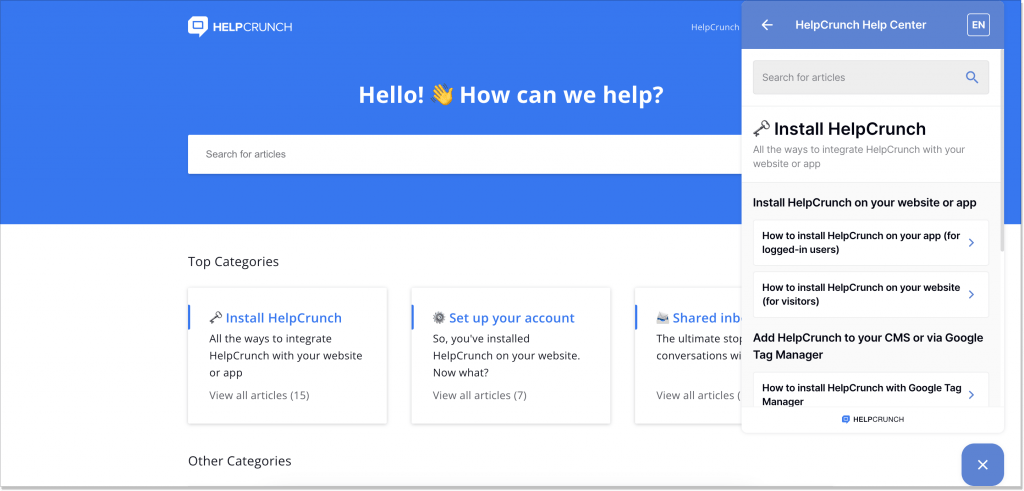
3. Collect customer feedback
Owning a business comes with a price. Especially if it’s online. Since you don’t see visitors eye-to-eye, it’s next to impossible to fish out their thoughts about how they are satisfied with your brand. And yet possible!
As you already guessed, a bot is able to gather customer feedback in the nick of time. Only if it’s set up right. Thus, one of the most effective ways to do that for chatbots in business is through surveys.
Program your bot to gather specific information about customer experience, such as how long a client waited for their order, how hard it was to tweak their account, or how easy it was to scuttle through a help center. Sure thing, the questions for this survey depend on the business specifics and specialization. For instance, look at how a restaurant feedback chatbot can look like:
4. Select an omnichannel approach
Gone are the days when customers demanded connection via phone only. We may not realize it yet, but we have already stepped into the omnichannel era. What’s that?
Omnichannel means that a company unifies its interaction across multiple channels (chatbot, live chat, email, mobile app, social media, etc.). However, one of the key conditions for a successful omnichannel approach is that all those channels are interconnected. Thus, if a client’s initial contact with a business is a chatbot, where they dish on their issues, a human social media support rep should be able to swoop in seamlessly.
Alright, so let’s say you already have a business chatbot as your primary channel. Now, you should equip with a place where all your messages will flow. HelpCrunch just happens to provide it – a shared inbox. So correspondence from live chat, emails, Facebook, Twitter, Instagram, and the chatbot is kept here in chronological order:
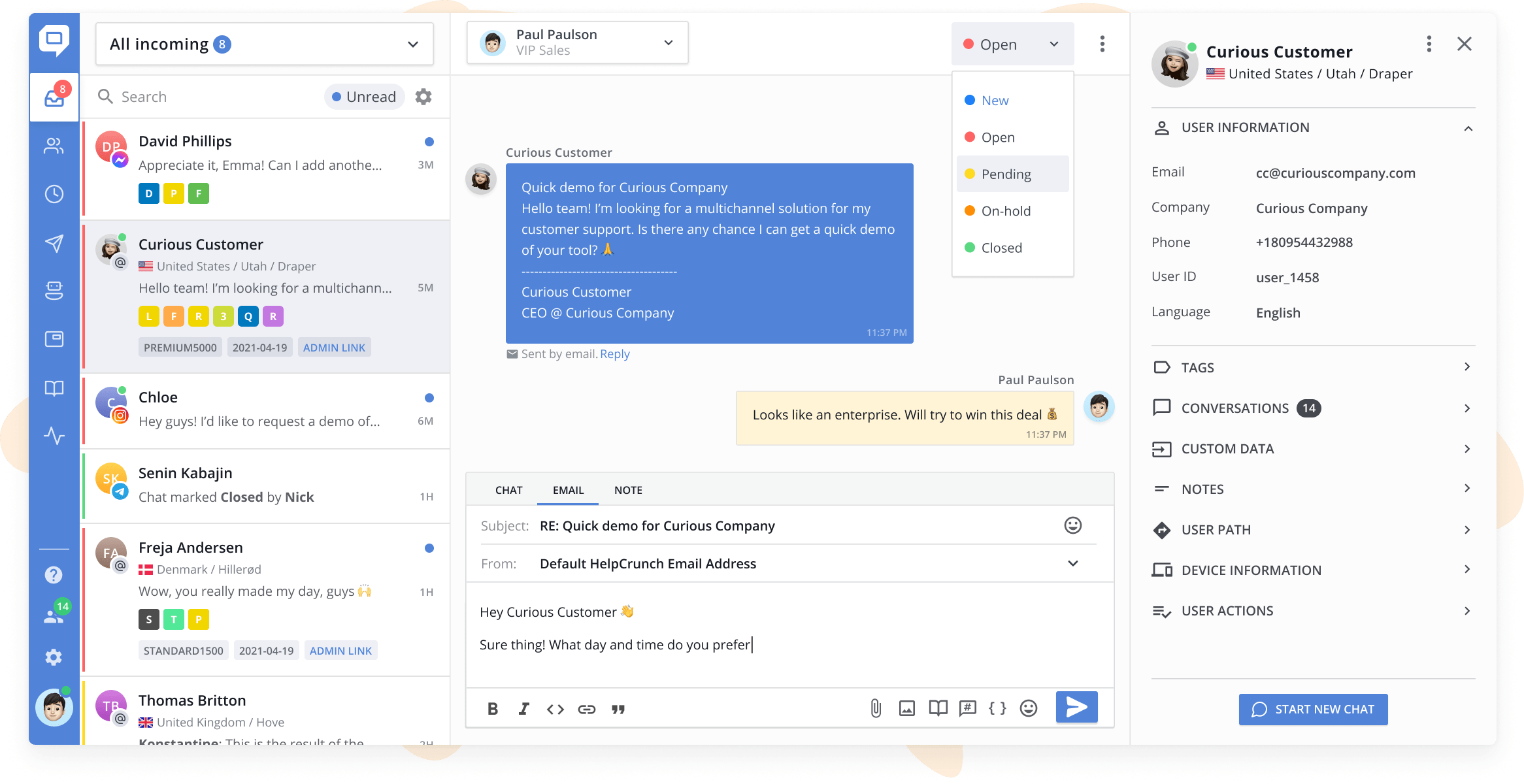
5. Use your chatbot as a personal assistant
You know how it happens in brick-and-mortar stores. A customer enters the room and a swarm of consultants bombards them with personalized product recommendations. Some might find this approach quite annoying (well, I do!). However, the situation climbs to a whole new level when a business chatbot joins the game.
To plant a better idea in your head, let’s take a closer look at this hypothetical chatbot ↔ customer conversation:
🤖 Holy guacamole! Your choice rocks! Here’s a little secret: this [insert the product a customer is trying to buy] is a limited edition. How about [a complementary product/service a client won’t refuse]? I will reach out to you when it’s time to replenish your supplies!
🙋♂️Wow! Thanks for the recommendation! How did you know that I needed that?
🤖 That’s pure magic! By the way, I see that it’s not your first visit. Do you want me to clarify some details for you?
🙋♂️ Now that you said that…can you please clue me in on your VIP packages?
🤖 Absolutely! So…
As you can guess, this friendly dialogue could go on and on. The secret is in detecting customer preferences, purchase history, and user path on a website precisely. Then the AI algorithms can shamanize a little to recommend products and services that align with the needs and interests of a particular user.
Imagine the myriad of benefits you are about to discover with a chatbot for business. Not only do you increase customer loyalty by providing a delightful experience, but you also amplify the sales revenue and collect better insights.
However, chatbots as personal virtual assistants go a longer way than just upselling and cross-selling. For instance, a year after Marks & Spencer’s chatbot saw the light of day, it has saved online sales worth $2.5 million that the company could have otherwise lost 😯
6. Stimulate your sales process
Speaking of sales from the last paragraph…do you know that AI conversational commerce (chatbots in business, smart speakers, SMS) will reach $290 billion by 2025? On top of that, half of the sales are expected to happen…yep, via chatbots.
However, do not celebrate just yet. To thrive in this endeavor, a bot alone won’t be enough. A business would also need:
- A decent CRM system for managing customer requests and keeping them under the same umbrella;
- A user-friendly, up-to-date website that could let the brand incorporate a robot;
- A seamless connection between the chatbot and the CRM system so that no customer data would fall through the cracks.
To be completely honest with you, all of the above is a bare minimum for leading a business to sales success. What are the other ways to utilize a chatbot for this endeavor?
- Special forms: for orders, sign-ups, demos, and consultations, to name a few. They can gather customer contact data, and you can leverage it in your further activities. The ideal example of such a business chatbot is powered by ATTITUDE – a beauty products company. Instead of simply recommending a user product from a catalog, they gather their email (the secret for enlarging your customer database):
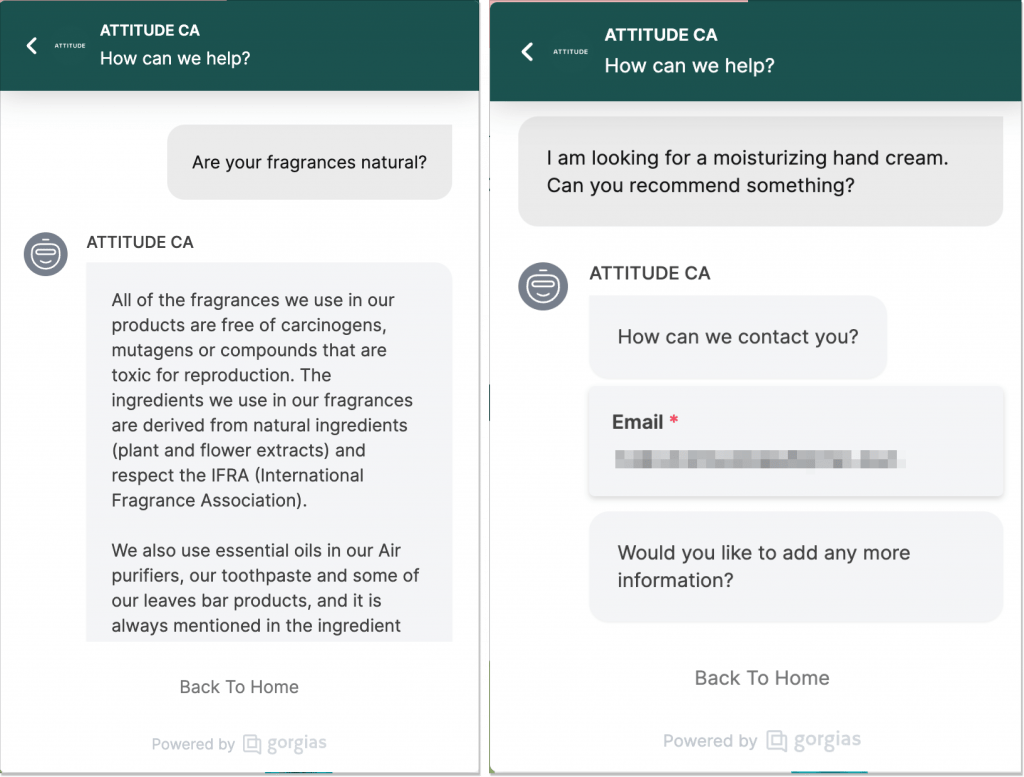
- Promos: craft your discounts and add them to your chatbot. Plus, make sure the bot sends them at the right moment to yield maximum results.
- Interactive product demos: users request a demo of a specific product and the chatbot guides them through a virtual experience, showcasing the product’s features, benefits, and usage scenarios. This hands-on approach can effectively showcase the product’s value and increase the likelihood of a sale.
- Customized pricing and quotations: by collecting information about the customer’s requirements, budget, and preferences, the business chatbot can provide tailored pricing options and generate quotes instantly. This personalized guideline simplifies the purchasing process and enables customers to make informed decisions.
- Virtual try-ons and Augmented Reality (AR): for businesses offering clothing, accessories, or cosmetics, chatbots can integrate virtual try-on features and augmented reality experiences. Customers can upload a photo or use their device’s camera to visualize how products would look.
7. Communicate in multiple languages
¡Hola! Soy tu asistente personal. Estoy listo para responder a todas sus preguntas!
Imagine how excited a Spanish client would be if a customer service rep greets them in their native language. Let alone a fully programmed chatbot.
The thing is that it feels relatable if a business is on the same wavelength with its clients. Plus, it only tops the overall acknowledgment. Such an approach pieces out the feeling of connection with a brand as speaking the same tongue will show your genuine readiness to be there for your clients. Not to mention that hype personalized experience everyone is buzzing about…
How do chatbots for businesses know what language to speak? No hocus-pocuses here. AI, NLP (Natural Language Processing), and other modern tech are breaking in:
- IP address – bots determine the location of a client and identify their language;
- Customer’s choice – a client can simply choose for their tongue before starting a dialogue;
- Web browser settings – a chatbot tracks the user’s web preferences and sticks to it;
- HTML string – this is one of the easiest ways to adapt to the language a customer speaks.
A very bright example of using a chatbot for business in a foreign language is presented by ePortugal – a web portal for Portuguese citizens and tourists. The virtual assistant has, obviously, informed me about specific rules of service in the country. But once I asked it if it could speak English, Sigma the chatbot magically switched over to it!
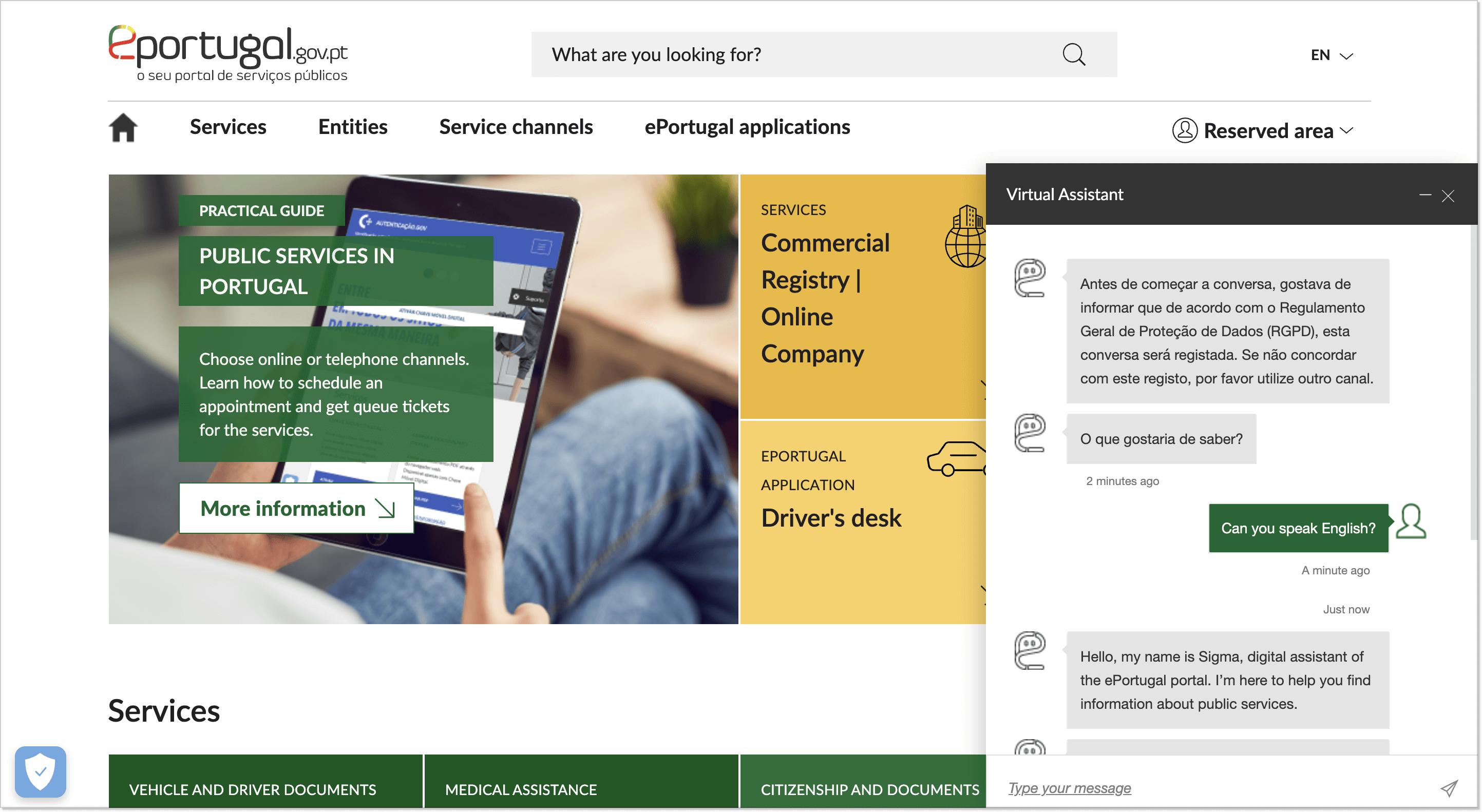
3 companies that use chatbots to fuel business growth
1. Brussels Airport: BRUce
In my quest for a chatbot for businesses, I stumbled upon this curious case. Meet BRUce – a bot residing in the Brussels Airport. This example caught my eye in seconds because of several things:
- BRUce facilitates an omnichannel approach – it provides you with flight updates in the widget in real time and offers you to receive them via WhatsApp and Facebook Messenger;
- BRUce asks for your feedback right off the reel – it offers a scale from 1 to 5 which is intuitive and well-spread;
- BRUce can assist you with parking booking – all you have to do is select a relative option from the Menu, and you will be transferred to the corresponding page;
- BRUce serves as a Lost & Found bureau – it asks you clarifying questions concerning the luggage missing as well as the flight number, and then hands the dialogue over to a human rep.
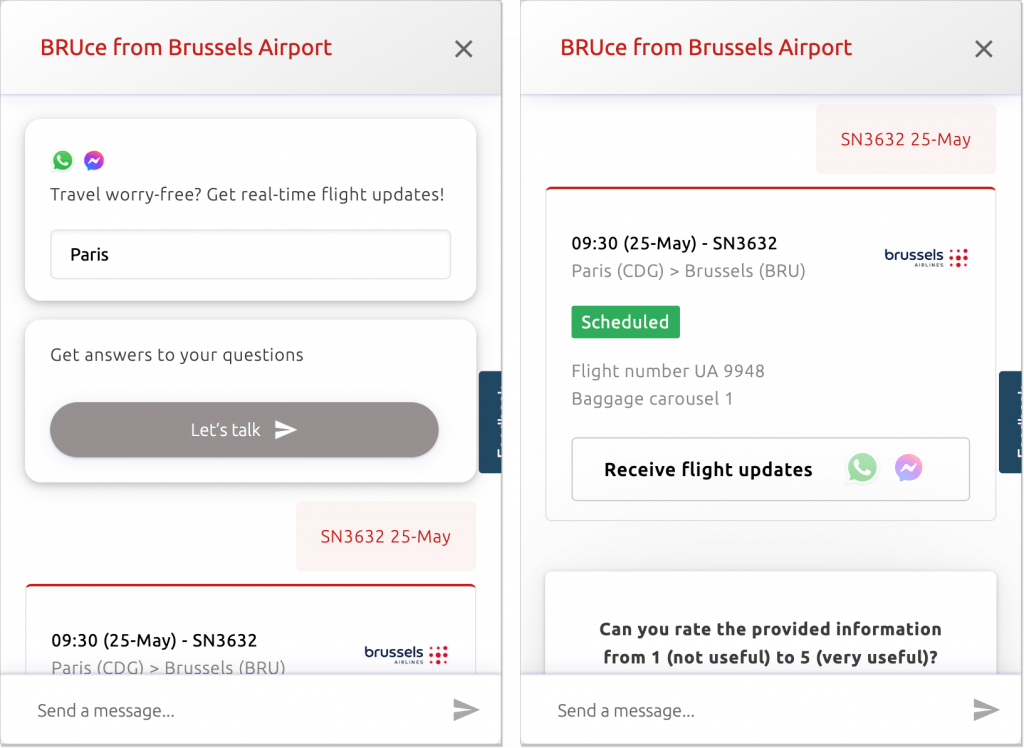
2. Capital One: Eno for cultivating customer relationships
Capital One – an American bank holding company – has developed Eno the chatbot. It operates on mobile, on a desktop, as a text message, and in emails.
Front of mind, Eno the chatbot for business organization signals about security breaches via the app which is really convenient in our fast-paced world. Besides, the chatbot tracks users’ spending by monitoring their accounts and sends useful insights if need be.

As is common, the banking chatbot is available 24/7 so that customers can pay the bills, deal with their accounts, and control their cards hands down. What marches Eno to a different drumbeat is that it can tell jokes! 😄 Well, this is what I call “cultivating customer relations”.
3. Wealthsimple: Conversational AI
Wealthsimple is a Canadian investment management service. As the company grew, there was a need for a potent tool that could manage huge volumes of customers’ requests and alleviate the customer support staff workload. This is why they launched their Virtual Assistant.
This AI conversational chatbot for business is integrated with the company’s help center and is able to return the correct knowledge base articles whenever a customer needs the answer. As a result: no frustrated clients as everyone gets the solution to their problems in a matter of minutes.

What is the best chatbot for business in 2023?
1. HelpCrunch: a no-code chatbot flow builder
I will not tell you something you don’t know: HelpCrunch is a no-nonsense solution for growing your business with a chatbot!
We provide a completely codeless builder where you can develop templates for miscellaneous use cases, such as bug detection, customer data collection, lead qualification, etc. Just drag and drop the blocks and you’re all set. Plus, if you pair it with live chat and an integrated knowledge base, your customers will love you for that!
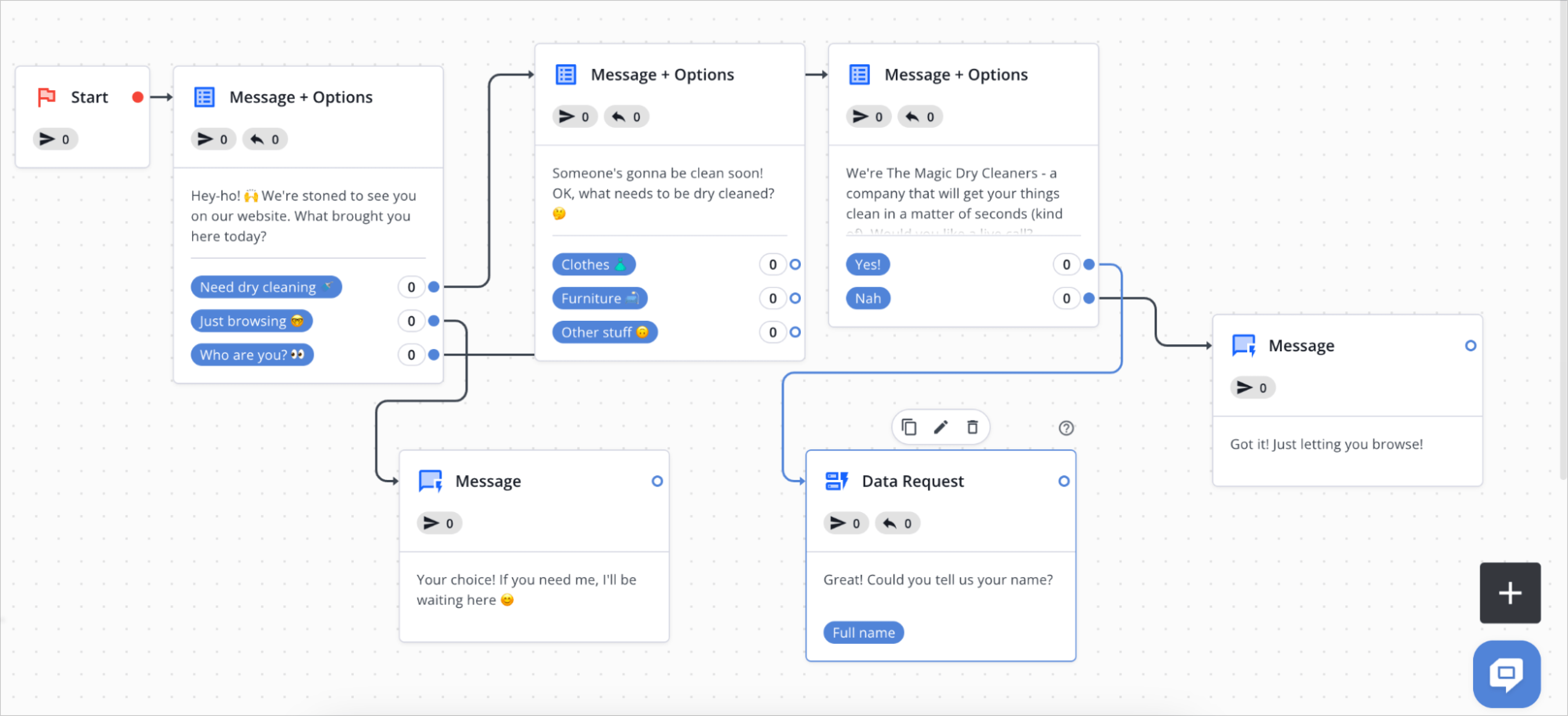
Pricing: HelpCrunch suggests the most transparent pricing out there, with $25/mo in Pro and the Unlimited package (annual only).
2. Tidio: a convenient bot for sales
If you’re in sales, ecommerce, and related niches, Tidio might be just the thing for you. The company specializes in live chat, however, it also provides a codeless chatbot builder for automating your routine. You can set up personalized messages to catch returning visitors, send product recommendations, and prevent cart abandonment.
But that’s only the tip of it. With Tidio, your customers can check their order status, see their purchase history, ask an FAQ bot questions for the full context self-service, and do so much more.
Pricing: Basic chatbots are free. For an upgrade, you need to pay at least $49/mo.
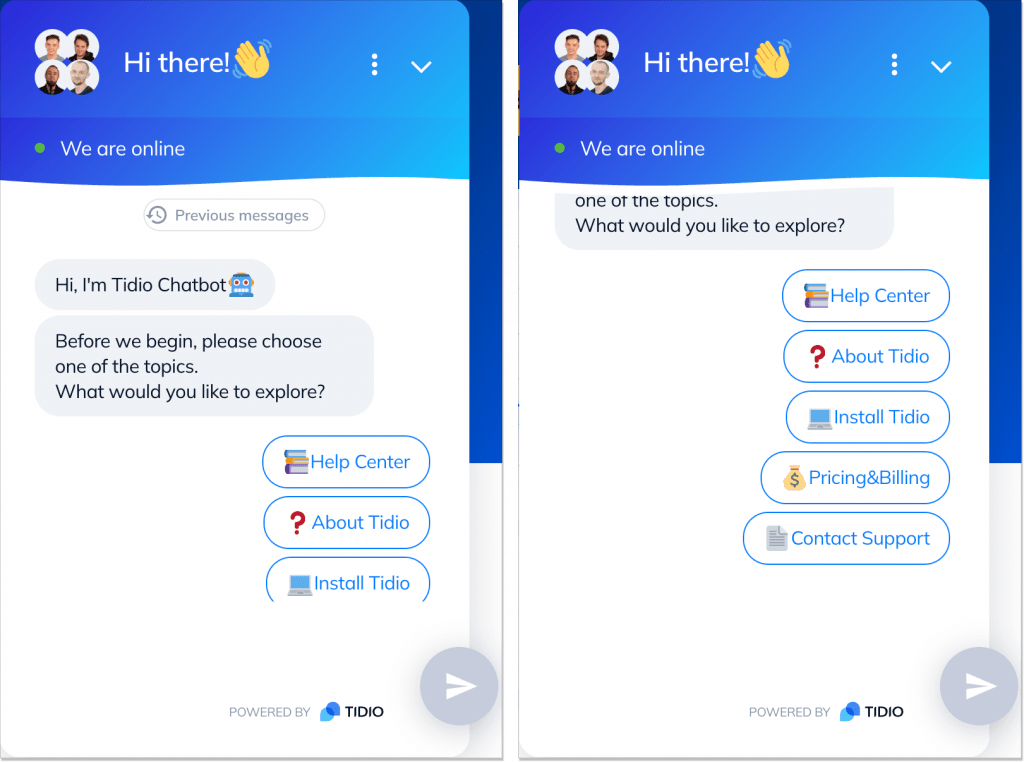
3. Aivo: AI-powered conversational bundle
Sure thing, I can’t pay attention to this AI chatbot. Aivo is a conversational platform that recognizes exactly what a customer is saying, even if it’s “Thank uuu!” instead of “Thank you!”. This brand would be a blast for nearly any industry. However, if your specialization is in telecoms, fintech, or retail – Aivo will bring you maximum results.
Pricing: To get Aivo’s pricing, you have to book a demo and get into specifics with the team.

So, would you go for a chatbot in business?
Or is it “Why should my business use a chatbot?” You are the only one who knows your brand like the palm of your hand. You are aware of all the challenges it overcame (and is supposed to overcome in the nearest future). And it is you who shape the picture.
To bring the matter to a point, chatbots aren’t those whimsy technological fads any longer. They revolutionize the ways businesses interact with their audience. They literally project their relevance to the feature. And to be up in arms for it, you have to team up with a trustworthy companion. Just saying that HelpCrunch might tune in perfectly 😉

